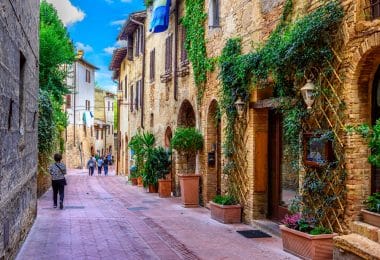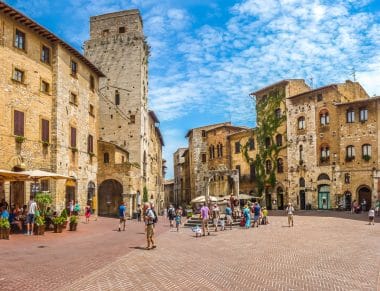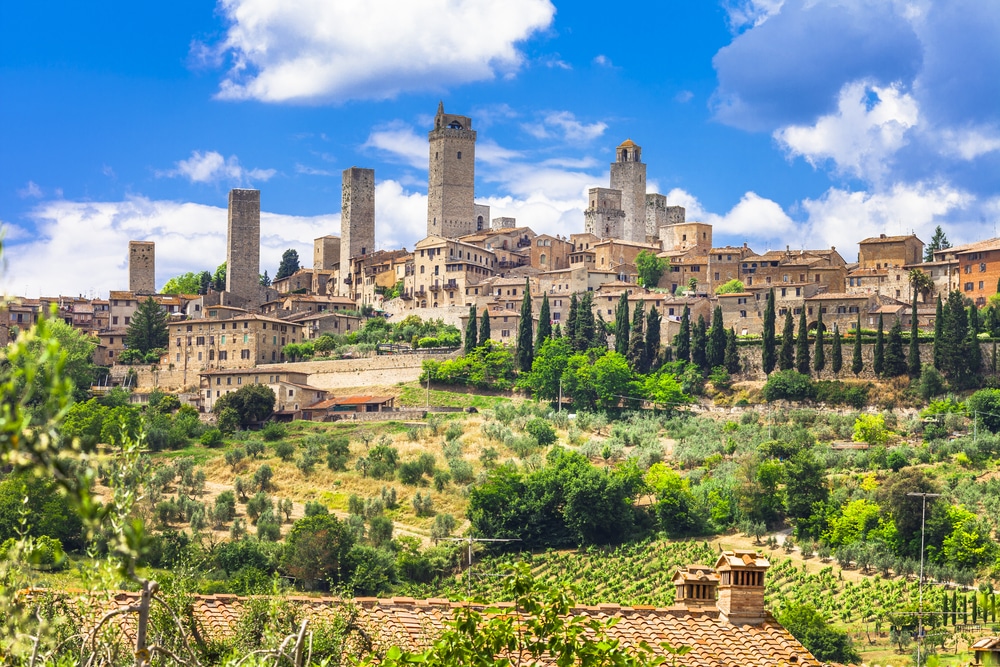San Gimignano – the word alone melts on the tongue, and anyone strolling along the coarse cobblestones of this Tuscan pearl will soon feel that the present is reflected in the past. In the shadow of the imposing family towers, the Middle Ages are present, and hardly any visitor can escape the grandeur of this backdrop. Without a doubt, San Gimignano is something like the flagship of the province of Siena. With a unique skyline and a historically significant city center. The historical garb of the city, which is rich in sights, is surrounded by a defiant wall that survived the storms of the centuries largely unscathed.
The trip to the Manhattan of Tuscany
The best way to get around Tuscany is by car. The nearest airport is Florence Airport. It is located about 60 kilometers from San Gimignano. A trip by bus costs five to ten euros, but there is not much public transport in Tuscany, which is why a rental car is the better alternative. During the journey through the province of Siena , the city can be seen from afar. Today, 13 of the former 72 towers rise into the air and show the importance of the city in the Middle Ages. The towers were built by noble families and showed their status. The family with the highest tower had the most reputation. Most of the city’s buildings date from the 11. or 12th century. In the 16th century, the then Grand Duke decreed that no new buildings could be built within the city. Since then, time has virtually stood still. In 1990, the city was named a UNESCO World Heritage Site. The town is located on a hill and offers some good viewpoints over the nearby surroundings. The attraction of the city lies not only in the old town, but also in the landscape.
A walk through the old town
The old town of San Gimignano is car-free and invites you to take a leisurely stroll. At the southern end of the old town is Piazza Martiri de Montemaggio, where there are some parking spaces. A few meters away is the Porta San Giovanni, the former main gate of the city, and the journey into the Middle Ages can begin. The gate looks imposing and is well preserved. Along Via San Giovanni there are many small shops and museums. Tourists like to spend several hours on this street, as there are many souvenir shops, small cafes, museums and other shops. At the end of the street is the church Resti Chiesa San Francesco, a sacred building from the Middle Ages that is worth seeing. The Arc dei Becci gate is located at the entrance to Piazza della Cisterna. This square is triangular in shape and is surrounded by ancient stone houses. Here you will find the Gelataria Dondoli, a very famous ice cream parlour. In the middle of the square there is a medieval cistern. To the north is San Gimignano’s largest square, Piazza del Duomo. The square is located in the middle of the large collegiate church and seven towers. The square is considered the center of the city and it is worth watching the action from the large stairs of the church. With a glass of wine or an ice cream, locals and tourists take a short break from the hustle and bustle. At the northern end of the square is the church tower. It is the tallest tower in the city and offers a great view over San Gimignano and the surrounding area. It is worth tackling the 250 steps of the stairs.
A car-free stroll through history
The “Manhattan of the Middle Ages” should be discovered on foot, because the old town of San Gimignano, which has been ennobled as a UNESCO World Heritage Site, is car-free. Not far from Piazza Martiri de Montemaggio, visitors will find larger parking lots. Through Porta San Giovanni, one of the main gates dating back to the 13th century, the walk through a town that has maintained and preserved its medieval charm begins. To the south of Florence , this used to be a bustling marketplace where the farmers of the surrounding area presented their products. The houses in the 12. and 13th century of the so-called “family towers”. They were considered stone witnesses to the well-being of the influential families of this city. But they also bore witness to the strife of the nobility, which outbid each other in the height of its residential and defensive towers.
Station for pilgrims on the way to Rome

The most imposing of the towers still preserved today, which symbolized the power of the families residing here, stretches up to a height of 54 meters. Originally, it was supposed to be in the 13. and In the 14th century, there must have been more than seventy such slender buildings that shaped the image of medieval San Gimignano. The pilgrims stood there in amazement in front of these buildings. They chose a very special place above the valleys of the Val d’Elsa as a stop on their arduous journey from northern Europe to Rome. The historic Via Francignena, the “Frankenstraße”, was the center of this place and peppered with simple hostels, restaurants and hospitals. However, San Gimignano’s heyday hardly lasted longer than one and a half centuries. The plague was followed by the subjugation of the powerful neighbor Florence and finally insignificance for the community.
The character of the Middle Ages was preserved
San Gimignano has long since recovered from this, not least thanks to international tourism. Today, only 1,500 people live in the old town. They are sympathetic – but also business-minded – hosts of around three million guests a year. The impressive site received a strong boost in popularity from the UNESCO designation in 1990, and the designation as a World Heritage Site encouraged the authorities to restore a number of things that were in danger of falling into disrepair. However, the planners tried to preserve the medieval character of San Gimignano and not to make any compromises. And so the Palazzo del Podestá and the Palazzo del Popopolo present themselves with their everlasting charm of old times. This also applies to the Piazza della Cisterna, which owes its name to a historic fountain that can hardly be overlooked here.
Dante came as ambassador of the metropolis of Florence

At all times, San Gimignano was the destination of the Florentine artistic guard, who immortalized themselves here on frescoes or panels. The philosopher Dante Alighieri, creator of the “Divine Comedy”, also stayed here in 1300 as ambassador of the metropolis of Florence. He resided in the “Sala del Consiglio”, the reception hall of the Palazzo Comunale, which is well worth seeing, in the heart of the medieval city and not far from the Collegiate Church of the Assumption of the Virgin Mary. The frescoes on display there are masterpieces of the Florentine and Sienese schools of art. In the heyday of San Gimignano, it was the trade in saffron that made the people of this city wealthy. The towers of the city served the rich patricians as a dwelling and as a defensive facility. Almost all of them had a floor area in the form of a square and did not correspond to normal living comfort even at that time. However, intruders had a hard time seizing such a tower, because in the event of a threat, the owners saved themselves via rope ladders to the next floor. The building frenzy of the nobility was stopped one day because defects in the statics of some towers became noticeable. From then on, no tower was allowed to be built higher than that of the Torre Grossa town hall.
A glass of Vernaccia at sunset
14 of these towers are still the figureheads of San Gimignano, visible from afar. The oldest is the Torre Rognosa, which can be translated as “mangy tower”. This name is apparently a reminder that the building served as a dungeon for some time. After the decree of the authorities, according to which the towers were no longer allowed to grow into the sky, the Salvucci and Ardinghelli families decided to build two towers at once to manifest their claim to power. If you want to delve deeper into the history of art during a visit to the medieval city, you should go to the museums of San Gimignano. The Museo Civico exhibits works of art from the period between the 13th and 15th centuries. The municipality is also proud of its numerous first-class restaurants, where the culinary delights of Tuscany can be found on the menus. However, some holidaymakers limit themselves to a break in the shade of an archway or enjoy a glass of the famous Vernaccia, which was harvested here in the Middle Ages, on the old city wall at sunset.
Not only the old town is worth seeing
There are several hiking trails in the surroundings of San Gimignano. The so-called panorama circuit is 8.8 kilometres long and leads once around the centre of the city. There are many different perspectives on the skyline here. There are many vineyards and olive groves in the area. The hospitable operators are happy to invite you to a tasting. There are many small restaurants that serve local specialties and process local food. The staff is very nice and sometimes even German-speaking. Wine tastings are offered regularly and the delicious wine of Tuscany can be purchased directly from the estate. Some artists sit in the area and bring the picturesque surroundings and the skyline to canvas and paper. The paintings can be purchased directly from the artists and are a nice memory of your holiday in Tuscany.


